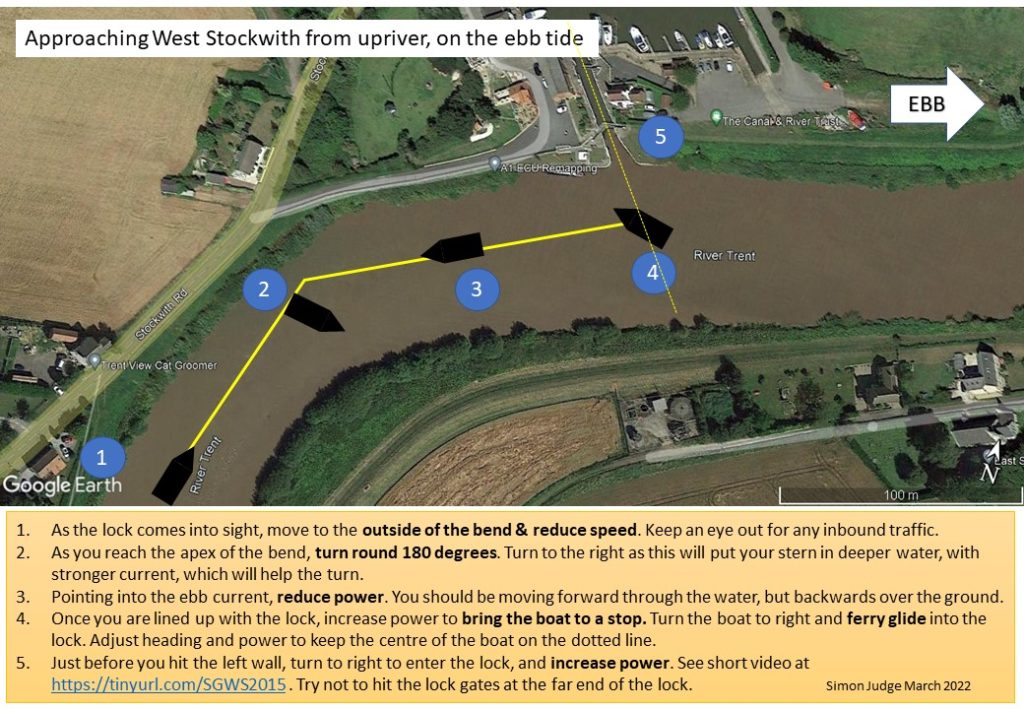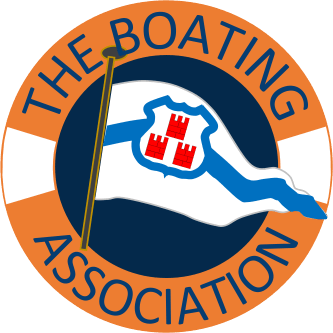This page contains links to some videos that you might find helpful:
- The entry to West Stockwith.
- The entry to Keadby (2 & 3)
- A dash from Keadby to West Stockwith (4)
- A more stressful journey, but lots of good learning points (5)
- Gainsborough (6)
- Links to just a few of the many other vlogs about the tidal Trent
Videos 1 – West Stockwith
How the locals do it! (well, some of them!)
Turning before the lock and drifting back, requires minimum power to get into the lock as the boat is in the “dead water” in front of the lock before he needs to push ahead…
But!
If there is an offshore wind, and/or not so much river flow, movements may need to be more exagerrated with more power needed.
Rest assured… Even the locals hit the walls occasionally, boating tends to be a contact sport anyway!!!
Here’s a diagram that may help

Videos 2 and 3 – Keadby
This on a day of weak river flow(?), and therefore worked fine on the day…but:
- Keep out of the way of boat manoeuvering ahead of you.
- Turn into the current early enough you dont have to “contend with” a strong outflow to get back to the lock (Boat in front did it fine!)
- Turning “stern towards lock” (so swinging through 270 degrees) looks wrong, but is prefered by some locals..
Video 4 – a tidal trip from Keadby to Stockwith – a longer video
This visiting narrowboat has been delayed by floods at Keadby, and despite the river still being in flood, with no tidal push AT ALL. they make a “dash” for West Stockwith. The 13 miles takes them 3.5 hours.
Locals – Should a narrowboat be on this section of river under these conditions?
Video 5 – a “Challenging” movie?
Should this Group, that is trying to encourage folk to the tidal river, show a movie about the river that calls itself a “Challenging” movie?
Well…. Of course we should, it’s the best way to learn?
These TWO narrowboats left Keadby for Cromwell having set themselves a deadline. Both had engine problems after about 3 hours…. (Were they running “too hard”? ..or was it just bad luck?) So such things happen… But after that, there are things that DID work for them that this Group is trying to promote:
1/ In going from north to south, the tide (initially at least) was flooding. Removing the concern of “hard grounding” on a falling tide, and giving time while one boat went to help the other.
2/ Two boats sailed as “Buddies” and had agreed communication methods. They stayed together, helping each other to reach Torksey.
3/ Both boats had VHF/ communications equipment that allowed communication when the first boat broke down, and subsequently with RCR and the lock keeper.
4/ Both boats were carrying anchors and ground tackle, that held them in the river flow. (12kg Danforth and chain) They used the anchors from both the stern and from the bow, without adding further problems, so appear to have had given thought to how, and when they would use the anchor beforehand.
Ultimatley… A little late, and apparently not a little “frustrated” (understandably!) they got into Torksey, but without injury, and without further damage.
So not too “Challenging”? But had they NOT followed the points highlighted (and too many boats dont?) the outcome might have been very different?
Video 6 – Gainsborough
A reminder of why that you need to consider when mooring at Gainsborough on a spring flood tide – the Aegir / tidal wave
And finally …
There are lots of “vlogs” on YouTube which you could go and search to see the river as it really is (No monsters!). Here are some to make it easy!
- Robbie Cumming (as featured on the BBC!)
- A film from the 1960s – how it used to be
- Early morning from Torksey to Cromwell – the river is beautiful!
- The whole river in four minutes

